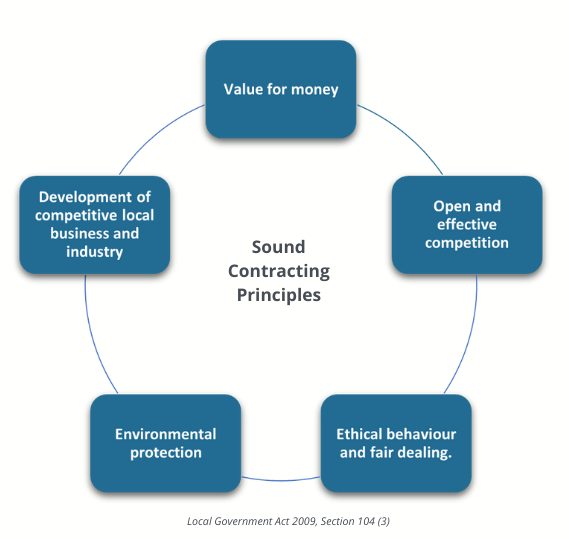Environmental protection within procurement
| Next Article |
Written by Michelle Lacey, Senior Procurement and Grants Specialist
By embedding environmental protection as a consideration in procurement processes, Councils are able to consider environmental impacts alongside procurement metrics such as cost and risk. The five sound contracting principles set out in Section 104 (3) of the Local Government Act 20091 (image 1), when procuring goods and services in Local Government, must be considered by Council(s), and offerors must quantify these principles in submissions. That process then creates the question; how is environmental protection considered, quantified and assessed?

Image 1
In November 2021 the Queensland State Government delivered its inaugural Sustainability Report 2 and in consideration of the countless natural disasters of 2022, the focus on the fourth Sound Contracting Principle – Environmental Protection, is at the forefront.
Environmental protection in procurement seeks to reduce the environmental impact of purchasing goods and services. Advantages include lowering the carbon footprint, promoting a circular economy of reusing and recycling, diverting waste from landfill, and innovation in areas such as sustainable packaging, design processes, and the use of renewable energy.
There are increasing expectations of the greater community to demonstrate its approach to considering Environmental, Social and Governance (ESG) factors in its decision-making and a greater consideration in Local Government Procurement.
The objective of the environmental protection, within the Sound Contracting Principles, is to maintain a commitment to long term ecological sustainability through procurement and contracting activities that conserve resources, save energy, minimise waste, protect human health and maintain environmental quality and safety.
As procurement professionals, we all need to promote the procurement of environmentally sustainable goods and services that satisfy the value for money criteria, which endeavours to encourage environmentally responsible activities, foster the development of products and processes that lower environmental and climatic impact. We also need to be an example to business, industry and the community by promoting the use of climatically and environmentally sustainable goods and services, for example, ensuring suppliers clean up construction sites, and disposing of waste including dust suppression in line with Council’s Waste Management Strategy.
Protection of the environment is paramount, and the following elements of sustainability may influence the selection of suitable suppliers:
- Systems for environmental management in construction processes,
- Corporate social responsibility,
- Greenhouse gas and carbon emissions,
- Commitment to sustainability and demonstrated sustainability improvements,
- Packaging and the production, control and disposal of waste,
- Appropriate management of raw materials to ensure a sustainable resource,
- Transport and logistics.
Understanding a supplier’s ESG footprint and therefore, the environmental protection of the entire value chain, leads to an understanding and the ability to quantify the risks (both reputational and operational) associated with suppliers that may have poor environmental protection and ESG strategies.
When applying the environmental protection principles within Local Government, there are a number of factors that should be considered, including:
- Water use and water quality impacts,
- Resource use, including the use of non-renewable resources,
- End-of-life options (e.g. recyclability, designing out waste, reuse),
- Impact on Country,
- Noise, pollutants, and emissions, and,
- Waste material from the project being disposed of according to Council’s Waste Management Facilities requirements that operate under a Council’s Waste Management Strategy.
The Environmental Strategy that Council normally operates in line with, is to guide Council and community action in responsible environmental management, sustainability, and stewardship to ensure that the region is preserved for future generations.
The majority of a Council’s environmental protection lies with its suppliers. Procurement leaders who take bold action can make a decisive difference in sustainability. Councils have many reasons to focus on environmental protection, from satisfying an increasingly aware community, to wanting to stay ahead of more stringent regulations, and needing to understand and manage environmental impact through every part of their operations in real time.
Mitigating risks through procurement can be achieved by introducing a requirement that all potential suppliers provide documentation of their ESG practices as part of its standard RFx process. Since the cost of mitigating the ESG risk would outweigh any potential savings offered by suppliers without sound ESG practices, the inclusion of such criteria in primary supplier qualification is critical to environmentally sound procurement principles.
For the third year in a row, the World Economic Forum’s Global Risk Report3 has been dominated by environmental risks where once they were economic ones. In our post pandemic world, environmental and social risks remain at the top of the list for both the short and long term.
Including “sustainability as standard” in procurement processes is an effective way to reduce ESG-related risks and identify opportunities for incremental improvements, within environmental protection. It can also help to ensure that procurement teams and their internal business units are aware of the environmental and social impact of purchasing decisions.
Council has the ability to make meaningful changes and positive impacts through sourcing different materials or different manufacturing and construction processes, as well as collaborating with suppliers in new ways. There is great potential to align procurement procedures with sustainability strategies, and through innovative leadership, the opportunity exists to create positive environmental outcomes in which communities and regions thrive.
During the evaluation of environmental protection look for an Environmental Management System which can be utilised to find innovative ways in which we can engage with suppliers and support environmental protection.
1 https://www.legislation.qld.gov.au/view/pdf/inforce/current/act-2009-017
2 https://s3.treasury.qld.gov.au/files/Queensland-Sustainability-Report-November-2021-1.pdf
3 https://www.weforum.org/reports/global-risks-report-2022/